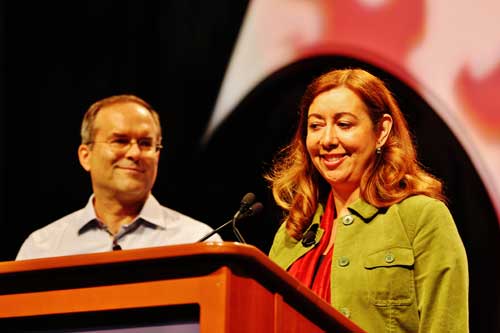As communication experts, we have worked with conservation biologists for 15 years – with the Smith Fellows program, TNC, WWF, and at SCB's 2013 International Congress for Conservation Biology. We’ve noticed some common mistakes scientists make when they communicate.
Here are the top four:
1. Speaking in terms of scientific accuracy is not convincing.
The issue of “certainty” is a great example of this. Scientists are trained skeptics, so they back away from certainty. But outside the realm of science, people interpret expressions of certainty as more likely to be true than expressions of cautious probability. Politicians and corporate spokespersons declare they are “certain” that a proposed mine is safe, that a certain chemical doesn’t cause cancer, or that climate change is a hoax.
It’s a losing tactic to insist on speaking of certainty only in the scientific sense. Instead, think about how you can speak with certainty in the commonly understood sense. For example, you can say with certainty: “According to NASA, 97% of climate scientists agree the climate is warming. I’m certain the risk is great and we need to act now.”
 |
|
Tim Ward and Teresa Erickson, authors of The Master Communicator's Handbook, speak at a plenary session on science communication at ICCB 2013 in Baltimore, Maryland, USA. |
2. If you don't have a seat at the table, you won't have a voice at the table
We learned this principle from former SCB executive director, Dr. Alan Thornhill, who now works for the US Department of the Interior. He told us that at many meetings where policy decisions were being made, he was the only scientist in the meeting. There were many times others turned to him with scientific questions, only because he happened to be in the room. During other discussions he would interject with, “Hold on a minute, we have to look at the scientific research on that before we decide.”
Find where the gaps are, where science has no seat at the table. Get on committees, go to hearings. Show up, so science has a voice.
3. Assuming the facts will speak for themselves: they don't. You must advocate for the facts.
Communicating for influence is a matter of survival of the fittest. It’s not enough to deliver your information. You are competing with other voices. For example, a Louisiana biologist we worked with shared this story with us: “I spoke in front of the metro council here in Baton Rouge...I knew the media was there, so I decided to try a quotable statement just to see if I could get one sticky enough to make the paper. There were more than 10 people who spoke in support of the ordinance, and my quote, as designed, was the only one that made it.”
Use memorable quotes and messages to make your facts stick.
4. Focusing on evidence, not on relevance.
Scientists too readily dive into the details of their research when speaking in public. It’s as if they are giving a lecture at university. But in the real world, if people don’t know why the topic is important to them, they won’t pay attention, and they won’t be listening when you get around to relevance at the end of your talk.
For example, we recently worked with a team or researchers in Texas who are studying the density and variety of milkweed plants in the state. With great relish they talked about their methodology. Only with much prompting did we get them to start with why they were doing this research – because milkweed is essential food for monarch butterfly caterpillars. If milkweed is in decline, the butterfly might end up an endangered species. Starting with the monarch (Texas’ state insect) gives people a reason to listen.
In sum, communication is not about output, it’s about impact.